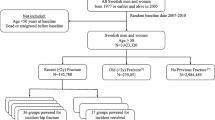Abstract
Using digital X-ray radiogrammetry (DXR) on hand radiographs from a large population-based study, 1,370 postmenopausal women were evaluated in a prospective fashion; fracture occurrence was compared with DXR measurements of historic radiographs. Further, the aim of the study was to evaluate factors affecting DXR bone mineral density (BMD) in this cohort. The study is based on data from a subgroup of women participating in the third Copenhagen City Heart Study and additional data from a questionnaire obtained in 1999. The mean follow-up time was 6.1 years. During the observation period, 245 women suffered a fracture. Odds ratios (ORs) per 1 standard deviation decline in DXR-BMD were statistically significant for fracture in the groups of wrist fractures, proximal humerus fractures, vertebral fractures, and other fractures as well as in the total fracture group. In the hip fracture group, the P value almost reached significance (0.052). The highest ORs (2.4) were found in the group with proximal humerus fractures and in the vertebral fracture group (2.0). In the wrist fracture and hip fracture groups, ORs were 1.7 and 1.4, respectively. The group with other fractures had an OR of 1.7, and the OR in the entire fracture group was 1.6. Age, fracture, and smoking were negatively correlated with DXR-BMD, whereas BMI, age at menopause, hormone replacement therapy, and physical fitness and muscle strength were positively correlated with DXR-BMD. In conclusion, BMD estimated by DXR of the metacarpals predicts later osteoporotic fracture and seems to provide meaningful information on bone mass in epidemiological studies, where DXA measurements are not available.



Similar content being viewed by others
References
Schnohr P, Jensen G, Nyboe J, Tybjærg Hansen A (1977) Østerbroundersøgelsen - Et prospektivt kardiovaskulært populationsstudie af 20.000 mænd og kvinder. Ugeskr Laeger 139:1921–1923
Appleyard M (ed) (1989) The Copenhagen City Heart Study. Scand J Soc Med Suppl 41:3–9
Rosholm A, Hyldstrup L, Baeksgaard L, Grunkin M, Thodberg HH (2001) Estimation of bone mineral density by digital X-ray radiogrammetry: theoretical background and clinical testing. Osteoporos Int 12:961–969
Jørgensen JT, Andersen PB, Rosholm A, Bjarnason NH (2000) Digital X-ray radiogrammetry: a new appendicular bone densiotometric method with high precision. Clin Physiol 20:330–335
Nevitt MC, Cummings SR, Browner WS, Seeley DG, Cauley JA, Vogt TM, Black DM (1992) The accuracy of self-report of fractures in elderly women: evidence from a prospective study. Am J Epidemiol 135:490–499
Bouxsein ML, Palermo L, Yeung C, Black DM (2002) Digital X-ray radiogrammetry predicts hip, wrist and vertebral fracture risk in elderly women: a prospective analysis from the study of osteoporotic fractures. Osteoporos Int 13:358–365
Black DM, Palermo L, Sørensen T, Jørgensen JT, Lewis C, Tylavsky F, Wallace R, Harris E, Cummings SR (2001) A normative reference database study for Pronosco X-posure system. J Clin Densitom 4:5–12
Bach-Mortensen P, Hindsø K, Jensen K, Jensen T, Hyldstrup L (2001) Prediction of osteoporotic fracture by digital X-ray radiogrammetry and DXA. A case-control study of three different fracture types (poster-abstract). J Bone Miner Res 16(suppl 1):S458
Dargent-Molina P, Poitiers F, Bréart G (2000) In elderly women weight is the best predictor of a very low bone mineral density: evidence from the EPIDOS study. Osteoporos Int 11:881–888
Omland LM, Tell GS, Ofjord S, Skag A (2000) Risk factors for low bone mineral density among a large group of Norwegian women with fractures. Eur J Epidemiol 16:223–229
Broussard DL, Magnus JH (2004) Risk assessment and screening for low bone mineral density in a multi-ethnic population of women and men: does one approach fit all? Osteoporos Int 15:349–360
Gerdhem P, Obrant KJ (2002) Effects of cigarette-smoking on bone mass as assessed by dual-energy X-ray absorptiometry and ultrasound. Osteoporos Int 13:932–936
Gnudi S, Sitta E (2005) Clinical risk factor evaluation to defer postmenopausal women from bone mineral density measurement: an Italian study. J Clin Densitom 8:199–205
Acknowledgments
The authors thank laboratory technicians Lea Heine Jensen and Lena Vind and study nurse Annelise Lysgaard for their committed assistance with the measurements, as well as Torben K. Sørensen (Statcon ApS, Kokkedal, Denmark) for statistical assistance.
Author information
Authors and Affiliations
Corresponding author
Rights and permissions
About this article
Cite this article
Bach-Mortensen, P., Hyldstrup, L., Appleyard, M. et al. Digital X-Ray Radiogrammetry Identifies Women at Risk of Osteoporotic Fracture: Results from a Prospective Study. Calcif Tissue Int 79, 1–6 (2006). https://doi.org/10.1007/s00223-005-0260-z
Received:
Accepted:
Published:
Issue Date:
DOI: https://doi.org/10.1007/s00223-005-0260-z




